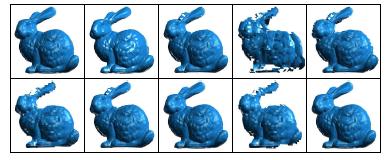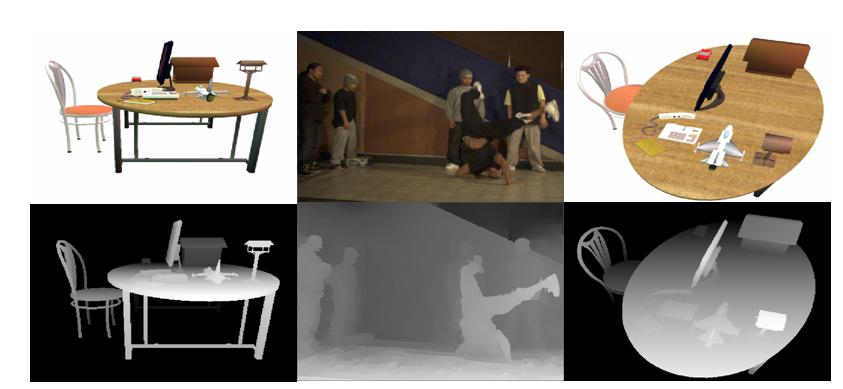Depth-Image Representations
Introduction
Depth Images are viable representations that can be computed from the real world using cameras and/or other scanning devices. The depth map provides a 2 and a half D structure of the scene. The depth map gives a visibility-limited model of the scene and can be rendered easily using graphics techniques. A set of Depth Images can provide hole-free rendering of the scene. Multiple views need to be blended to provide smooth hole-free rendering. Such a representation of the scene is bulky and needs good algorithms for real-time rendering and efficient representation. A GPU-based algorithm can render large models represented using DIs in real time.
The image representation of the depth map may not lend itself nicely to standard image compression techniques, which are psychovisually motivated. The scene representation using multiple Depth Images contains redundant descriptions of common parts and can be compressed together. Compressing these depth maps using standard techniques such as LZW and JPEG and comparing the quality of rendered novel views by varying the quality factors of JPEG can give us a good trade-off analysis between the quality and compression ratio. Multiview compression of texture images can be performed by exploiting the constraints between views such as disparity, epipolar constraint,multilinear tensors, etc.
GPU Rendering & DI Compression
We aim at rendering big,complex scenes efficiently from their Depth maps. Some of the features of the system are ::
- The novel view point is not restricted and can be anywhere in the seen, unlike view morphing.
- The visibility-limited aspect of the representation provides several locality properties. A new view will be affected only by depths and textures in its vicinity.
- Use of multiple depth images to fill in the hole regions created due to the lack of complete information in a single depth map.
- Only Valid views according to the thresholding angle are processed for the rendering, there by reducing the computation time.
- GPU algorithm gives a multiple times better FPS than the CPU algorithm.
- Frame buffer objects and Vertex Buffer objects improve on the performance and memory management of the rendering.
- Resolution can be changed by the subsampling the grid and thus reducing the number of primitves to be drawn.

- LZW Compression (lossless technique) is applied on depth maps using gzip
- JPEG Compression :: Depth maps are compressed with various quality factors.
- Quad Tree Based Compression :: If the block of any image/depth map represents one particular value it is stored as one single node in the tree.
- MPEG compression :: All the frames are used to generate a movie sequence to get the encoded image.
- Geometry Proxy Model :: It is an approximate description of the scene used to model the common, position independent,scene structure.
- Progressive Compression :: Differences are added bit by bit progressivly this allows for smoother levels of detail.
- Quality Levels :: Levels of Details (LODs) are varied to control the rendering time through the number of primitives or size of the model and texture.
Related Publication
Pooja Verlani, Aditi Goswami, P.J. Narayanan, Shekhar Dwivedi and Sashi Kumar Penta - Depth Image: representations and Real-time Rendering, Third International Symposium on 3D Data Processing, Visualization and Transmission,North Carolina, Chappel Hill, June 14-16, 2006. [PDF]
Sashi Kumar Penta and P. J. Narayanan, - Compression of Multiple Depth-Maps for IBR, The Visual Computer, International Journal of Computer Graphics, Vol. 21, No.8-10, September 2005, pp. 611--618. [PDF]
P. J. Narayanan, Sashi Kumar P and Sireesh Reddy K, Depth+Texture Representation for Image Based Rendering, Proceedings of the Indian Conference on Vision, Graphics and Image Processing(ICVGIP), Dec. 2004, Calcutta, India, pp. 113--118. [PDF]
Associated People
- Pooja Verlani
- Aditi Goswami
- Naveen Kumar
- Saurabh Aggrawal
- Shekhar Dwivedi
- Sireesh Reddy K
- Sashi Kumar Penta
- Prof. P. J. Narayanan

